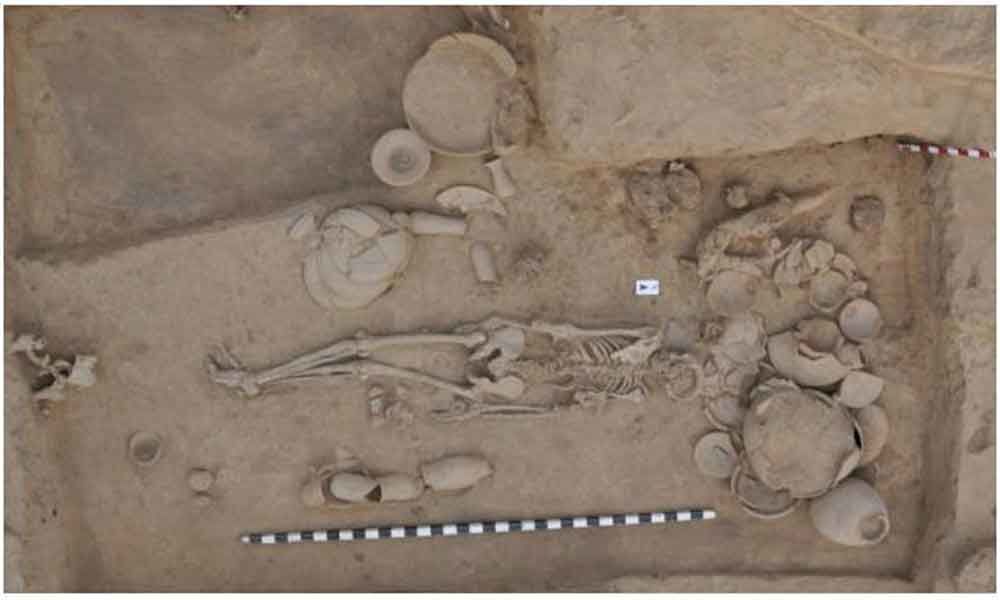Live
- Celta Vigo extend all-time club top-scorer Iago Aspas’ contract till 2026
- BGT: Kaif gives preference to Jaiswal-Rahul opening pair for Boxing Day Test against Australia
- Odisha CM Majhi, Naveen Patnaik extend Christmas greetings
- Icebreaker Keyboard: AluminIum Design Costing as Much as a MacBook Pro
- ‘Rifle Club’ Movie Review: A Stylish Thriller That Falls Short in Storytelling
- Chennai to Experience Heavy Rain as Severe Low-Pressure System Approaches Coastal Areas
- Pradeep’s ‘Akkada Ammayi Ikkada Abbayi’ hypes up with energetic new song
- Dil Raju releases ‘Adi Dha Saaru’ song from ‘Sahakutumbanam’
- GTA 5 Online Car Duplication Glitch: How to Duplicate Cars for Money (2024)
- 'Srikakulam Sherlock Holmes' Review: A quirky thriller thay doesn’t impress
Just In
DNA study finds genetic links of ancient humans


The International team of geneticists, archaeologists and anthropologists from North America, Europe, Central Asia, and South Asia, including Centre for Cellular and Molecular Biology (CCMB), Hyderabad, has analysed the genomes of 524 ancient individuals.
Habsiguda: The International team of geneticists, archaeologists and anthropologists from North America, Europe, Central Asia, and South Asia, including Centre for Cellular and Molecular Biology (CCMB), Hyderabad, has analysed the genomes of 524 ancient individuals.
This is the largest ever study of ancient human DNA, along with the first genome of an individual from the ancient Indus Valley Civilization. Both studies reveal unprecedented detail of genetic ancestry of South and Central Asia and Indus Valley Civilization (IVC). "We compared these ancient genomes to one another and to previously sequenced genomes, and put the information into context alongside archaeological, linguistic and historical records.
This has helped us fill in many of the key details about people who lived in various parts of this vast region from the Mesolithic Era (about 12,000 years ago) to the Iron Age (until around 2,000 years ago). We could study how these ancient humans (whose skeletons were found) relate to people who live there today," said Dr Kumarasamy Thangaraj, one of the senior authors of both the studies and chief scientist at CCMB.
The findings of the above studies have been published in two highly reputed scientific journals, Science (focusing on the ancestry of South and Central Asia) and Cell (focusing on a Harappan genome) on September 5. They answer long-standing questions about origins of farming, source of Indo-European languages in South and Central Asia and genetic affinities of the people of IVC, respectively.
These studies speak of two of the most profound cultural transformations in ancient Eurasia—the transition from hunting and gathering to farming and the spread of Indo-European languages, which are spoken today from the British Isles to South Asia – along with the movement of people.
For decades, experts have debated if Indo-European languages made their way to distant parts of the world via herders from the Eurasian Steppe - the 'Steppe Hypothesis' or with farmers moving west and east from Anatolia (present-day Turkey) - the 'Anatolian Hypothesis'.
The Indus River Valley was at the center one of the first civilizations of the ancient world, flourishing between 4,000 and 5,000 years ago. People built towns with populations in the tens of thousands. They used standardized weights and measures and exchanged goods with places as far-flung as East Africa.
"After screening more than 60 skeletal samples from the largest known town of the Indus Valley Civilization (IVC) called Rakhigarhi, in the northwest of India in the state of Haryana, we have shown that the Iranian-related ancestry in South Asians comes from a lineage that separated from Iranian farmers and hunter-gatherers before they split from each other," said Dr. Thangaraj.
He further adds, "This is consistent with the observation that this Iranian-related ancestry is extremely common even in tribal groups in southern India practicing hunting and gathering, not farming. This indicates that farming in South Asia was not due to the movement of people from the earlier farming cultures of the west. Instead, local foragers adopted it."

© 2024 Hyderabad Media House Limited/The Hans India. All rights reserved. Powered by hocalwire.com






